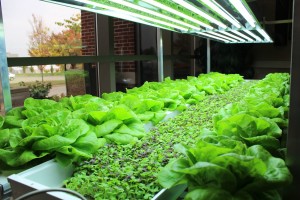WOOSTER, Ohio — California is more than 2,000 miles west of Ohio, but the historic drought the Golden State is experiencing could boost food production in Ohio, and in other states.
And, one way producers are looking to fill the gap is with indoor, controlled environment agriculture.
Speaking at an Oct. 22 gathering of indoor farming experts, Tony Logan, Ohio’s Rural Development director for the U.S. Department of Agriculture, said California has lost 1.2 million acres of food production the past year, due to the drought.
“Not only are the wells going dry, but land subsidence is occurring at a historically rapid pace,” he said. “The [Central] valley, which has been known forever as America’s vegetable basket, is literally sinking.”
Filling the gap
Logan said farmers have a lot of ways they can react — from doing nothing to filling the gap. He hopes Ohio growers will fill the gap, and invest in controlled environment food production, which can produce the most yield, for the least amount of water and nutrients.
“I think I know where those California veggies are going to be grown, and welcome to Ohio — America’s new vegetable basket.”

Success rate
But Bishop also knows that using greenhouses, and marketing the food in the end, isn’t easy. Only about 1 out of 20 entrepreneurs succeed, he said.
“When somebody calls me who says, ‘hey, I want to put up a hydroponics greenhouse,’ I get a red flag,” Bishop said. “They either never get it off the ground, or they do and they don’t have the tools to make it work.”
Phil Reitz, a banker for William Blair and Co., said things like sustainable food, healthy food and food security are all good features of indoor farming, but what bankers are looking for is profitability.
“The challenge is a logistics and a marketing question. … moving from an ideological carrying-the-flag of great food, security, sustainability — to make that into an economic proposition.”
Basic business
Sue Raftery, who coordinated the meeting, said there is a lot of opportunity and incentive for indoor production — but it still comes down to basic business principles.
“It still comes down to ‘will the investor get a return on their dollar, and will the business stay in business,’” she said.
Gene Giacomelli, director at the Controlled Environment Agriculture Center at the University of Arizona, said there is no doubt that controlled environment agriculture works — but not all projects are economical.
Still, controlled environments offer significant water savings, and can control the lighting and temperature in ways that outdoor farmers can only dream.
He said indoor agriculture will not replace outdoor farming, but gives producers the ability to maximize production, while making the best use of inputs.
New research
Meiny Prins, CEO of Priva, a Netherlands company that supplies research and greenhouse technology, said researchers have actually found that using less water can result in more food being produced.
A recent study showed a 20 percent boost in yield, by actually drying plants down to the point that they responded by producing more fruit.
“We stress out the plant so much that he almost thinks that he’s dying,” she said. “The less water you give, the more active the plant becomes.”
The indoor farming sector continues to develop new technology, and is attracting producers and consumers to the possibilities, and students who see a career in that field.
“It’s the sexiness of all of the new techniques that exist, and that can be adapted, that is going to attract the younger people to our sector,” said Prins.
But the sexiness still has to be rooted in business, and the challenge of feeding a hungry world, explained Peter Lane, of Peter Lane Foods.
Secondary uses
He said indoor farmers should look at ways to process their food waste into secondary products, such as tomato paste, or feed for livestock. He also suggested that growers look at ways to diversify their crop output beyond simple greens.
“You cannot feed the world on Romaine lettuce and microgreens, it just does not work,” he said. “That is for hipsters, and there are not that many hipsters in the world.”
The conference was hosted by AGROWN — a consulting and outreach organization for controlled environment agriculture. It also included a tour of the new greenhouses at the Ohio Agricultural Research and Development Center in Wooster.
STAY INFORMED. SIGN UP!
Up-to-date agriculture news in your inbox!











